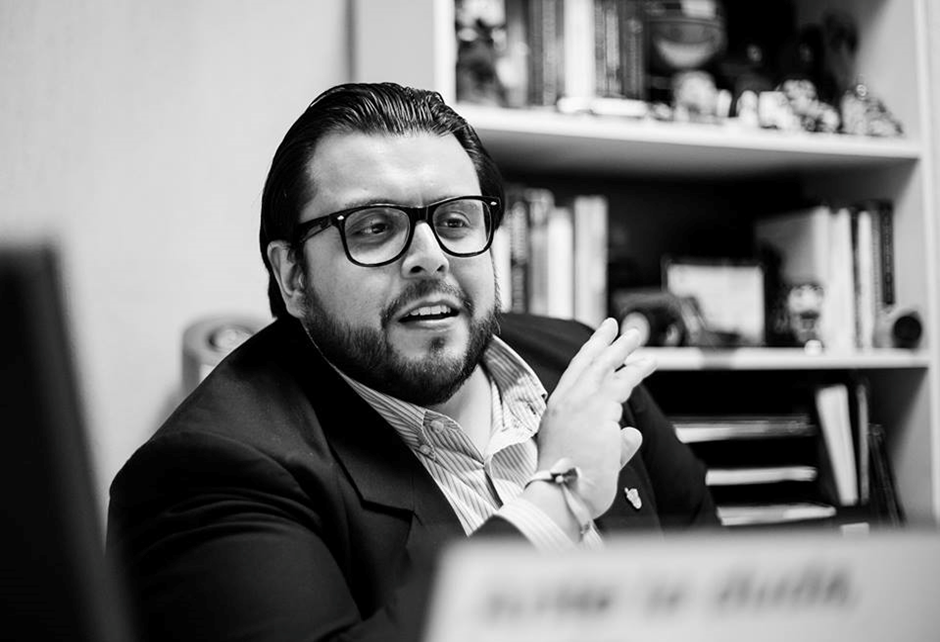When you step into his office, you can see the microphones on his desk, as well as a bunch of papers that look like homework waiting to be graded. Professor Francisco Orozco is about to record his next YouTube program with guest Christian Reich in his 2×2 cubicle. The content will also be uploaded to Facebook, Apple Music, Spotify and other platforms.
With a friendly demeanor, he sits on his ergonomic chair on the side of his desk, leaving to cushioned chairs for his co-anchor and tonight’s guest.
It’s 6:45 pm when the program starts. Today’s subject is the current state of international relations with the United States.
The professor, also an Associate Director for Accounting and Finance, has stood out thanks to innovation in his academic work at Tec de Monterrey.
The 33 years old academic also writes for specialized mexican magazines such as Alto Nivel and El Financiero. He also teaches at EGADE Business School in Monterrey.
He currently produces video tutorials for YouTube, has a blog in which he tackles relevant issues related to education and a podcast, which he distributes on various digital platforms.
“I think a class should be like storytelling. For my part, I think of every class as an episode of a Netflix series, and every term is like a season,” Orozco said in an interview with CONECTA.
The blog that started everything
“It all started with the blog, which is when I realized that an hour and a half of class was not enough to cover everything,” Orozco explains. This is how he decided to create a space to go in-depth with the course materials.
One of the subjects included in the class was family business management. To explain this, Orozco used the popular Netflix series Club de Cuervos as a reference.
“Students were so engaged that when the class was finished, they wanted more, this is why I created Emprepedia (in Spanish), a website that explains every subject included in the course.”
The website has registered more than fifty thousand visits, and it is estimated that it will grow over time.
YouTube tutor sessions
In addition to the blog, Ori, as his students call Orozco, teaches a class using YouTube’s platform.
“I decided to produce a supporting feature for the class, in which we review the content in a way anyone who had at least heard about the subject once could understand.”
Orozco says that students have found this content helpful because they can pause, rewind or forward the video to subjects that are still fussy. They have reached out to him to thank him.
This YouTube content raised students’ level of satisfaction in the Student Opinion Survey (ECOA, by its abbreviation in Spanish), one of the tools Tec uses to grade their teachers. The number of requests for tutor sessions has also decreased for students who watch these videos.
Expanding education’s reach
As part of his continuous educational exploration, the professor argues that even if knowledge can be in your pocket nowadays, there are still places it can’t reach.
This thought inspired him to start a new project with Christian Reich, a marketing professor at Tec de Monterrey Campus Monterrey. They both invested their own money to buy microphones and the proper equipment to record quality content.
“We think that a professor is not done when the class is finished. Students will look up to you for guidance, and it is up to you to make a positive impact in their life.” says Reich.
“This is why we created this podcast with the idea of reaching farther, to places where the internet is the only resource to ge to know the world, and we also strive to create a positive impact,” Orozco adds.
In these podcasts, Reich and Orozco bring in guests with vast experience in any given subject to interview them and get their perspective.
His series has 12 episodes now, and it’s on YouTube, Facebook, LinkedIn, Spotify, and other platforms.
Storytelling in class
None of this would have been possible without Orozco’s ability to keep the students’ attention in class, and CONECTA asked him further about his methods and strategies.
How do you prepare for your class?
“It takes about three hours to get ready for an hour and a half class. In that time, I research the content thoroughly until I am familiar with the latest about any given subject. Then I process it so I can convey it to my students through jokes, anecdotes, and interesting examples.”
How would an ideal class be according to you?
“I think a class should be based on storytelling. In my case, I think of every class as an episode from a series and every term is like a season. This way, I can give continuity to the content without losing the trail of the full course.”
What is a typical day in Orozco’s classroom?
“I like to refer to an example from when I teach an accounting lesson in which I tell them: ‘Close your eyes and imagine that you’re in a bottle factory, imagine the process of packaging, filling and tagging’. This is how we determine costs by analyzing processes. Then I start teaching them the theory.”
The professor points out that he has taken his students to a point in which they remember formulas because he associated them with a joke or anecdote, getting them to really understand the lessons.
Orozco’s interview concludes with his opinion about empathy. He refers to it as a fundamental skill for teaching, the teacher’s attitude will make or break the connection with the students.
Currently, Tec de Monterrey is about to implement a new educational model, TEC21, which will use experiential and challenge-based learning to develop competencies beyond knowledge.
This article was originally published in CONECTA.
This article from Observatory of the Institute for the Future of Education may be shared under the terms of the license CC BY-NC-SA 4.0 
)
)


)